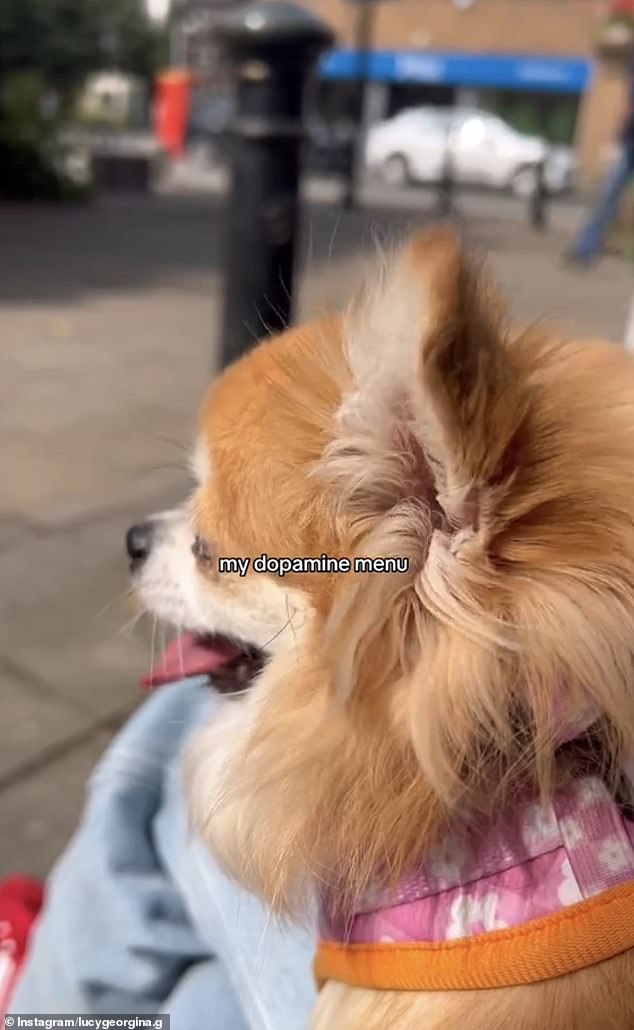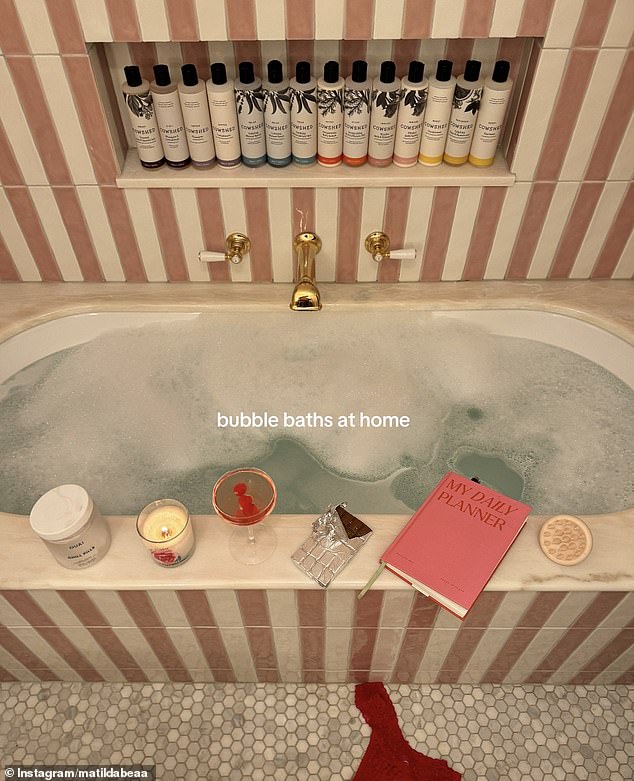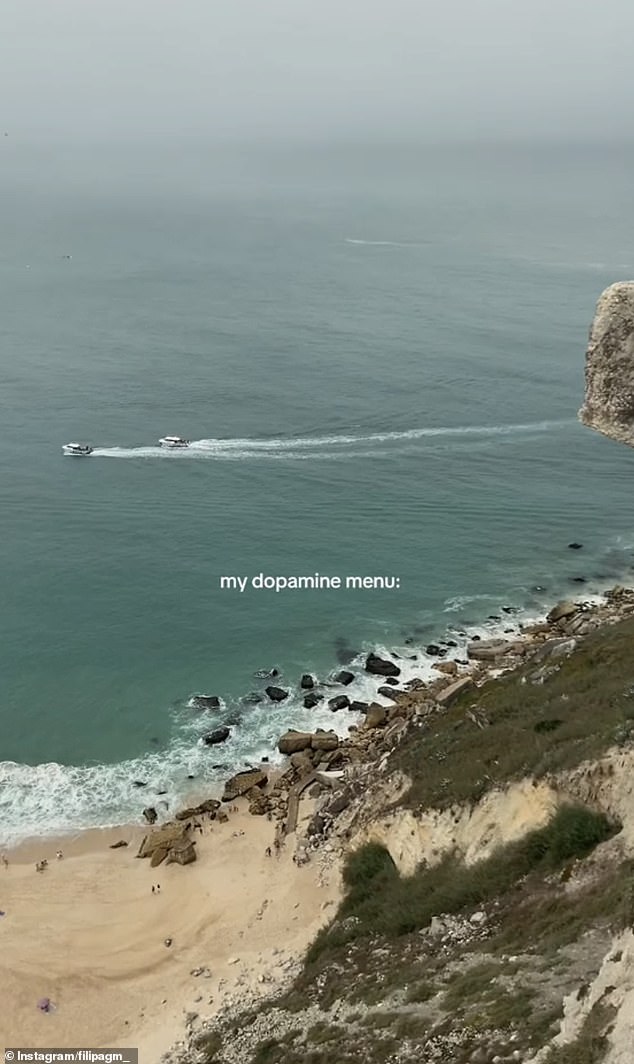Have Gen Z found the perfect formula for happiness? TikTokers share ‘dopamine menus’ as a way to bring joy into their daily routines – and it’s got the thumbs up from psychologists!
Everyone can use a little pick-me-up now and then when life gets tough. But whether there is a formula for happiness has long been debated.
However, Gen Z thinks they have the answer, as a trend is starting to emerge on TikTok: so-called ‘dopamine menus’. These are a list of daily activities or moments that generate happiness.
This trend has become increasingly popular on social media as a way to avoid doom scrolling or TV binges, as it gives you a list of natural dopamine boosters at your fingertips, without the need for technology.
TikTok and Instagram creators share their take on the trend that eschews technology and celebrates simple pleasures. Video montages feature snippets of flowers, candles, brisk morning walks, freshly baked pastries and colorful knits.
Dopamine menus can look like lists, but they are sometimes broken down into groups of appetizers (quick dopamine hits like natural sunlight or a favorite snack), main courses (time-consuming activities like baking or journaling), sides (ways to enhance boring tasks like housework or studying, like listening to music or a podcast), and desserts (dopamine hits that you only need to eat once in a while, like binge-watching a TV series or checking social media).
@happyolivestudio shared snippets of a handmade journal filled with stickers, scribbles and notes about her favorite things
Creator @lucygeorgina.g shared a snapshot of her sure-fire dopamine-rush activities involving latte art and baking, while @happyolivestudio shared snippets of a handmade journal filled with stickers, doodles and notes about her favourite things.
Meanwhile, London-based lifestyle influencer Matilda Bea shared a list of her favourite things to do, including ‘bubble baths at home’, ‘making holiday plans’, ‘hosting dinner parties’, ‘a fully stocked fridge’, ‘weekends with friends’, ‘sliding driveways’, ‘girls’ nights out’, ‘doing my make-up’ and ‘clean sheets’, to name a few.
For @filipagm_ it was much the same, with pastries, coastal views, bright flowers and paintings in her feed.
The soundtrack to many of these TikTok recaps is an audio clip from American podcaster Payton Sartain, who discusses the trend in an episode of her podcast Note To Self, titled ‘Building a dopamine menu’.
“I just discovered the concept of a dopamine menu, which is a list of things you can do to feel good throughout the day, so you’re not just scrolling through social media,” the voiceover says.
Dopamine is a neurotransmitter produced in the brain that is a vital part of the body’s reward system. People who struggle with low dopamine (for example, those with ADHD) will often chase quick fixes in the form of scrolling through social media, snacking, or shopping – also known as “high-stimulation behavior.”
The consequence of engaging in high-stimulation behavior is that we’re likely to experience a crash after the initial high, as clinical psychologist Ellen Littman PhD explains: “Dopamine-deficient brains experience a motivational spike after high-stimulation behavior causes a dopamine release.
‘But after that boost and reward, they return to baseline, but motivation immediately drops.’
The idea of a dopamine menu is to curb those cravings for high-stimulation activities and end the high-low cycle. Natural sunlight, spending time with a loved one or pet, relaxing with a book, meditation, and exercise are all known natural mood enhancers.

Creator @lucygeorgina.g shared a snapshot of her safe dopamine-rush activities involving latte art and baking

London-based lifestyle influencer Matilda Bea shared a list of her most joyful activities, including ‘bubble baths at home’, ‘making holiday plans’, ‘hosting dinner parties’ and ‘a well-stocked fridge’

For @filipagm_ it was much the same, with baked goods, coastal views, bright flowers and paintings in her feed
“Having a list allows us to proactively choose positive actions that will improve our mood, rather than falling back on habits that we know aren’t helping us be the person we want to be,” Dr Sophie Mort, mental health expert at Headspace and clinical psychologist, told FEMAIL.
‘This approach can improve emotional well-being by building a sense of control and balance, preventing feelings of boredom, anxiety or depression.’
While it may seem like a lighthearted TikTok moment, psychologists believe in this trend.
Bella von Nesselrode is a member of the Complementary Medical Association here. She works with neuroscientists and psychologists and said there is a lot of excitement about the concept of a dopamine menu as a way to combat negative dopamine-seeking cycles.
She told us, “Psychologists who treat people with ADHD recommend having a dopamine menu of things you can fall back on, for a more natural and well-earned source of dopamine.”
Dr. Sophie Mort also says it’s a valuable tool for people who are prone to procrastination.
“Procrastination often stems from the tendency to seek immediate gratification in less productive activities,” she explains.
‘We can tackle procrastination by breaking a task down into manageable chunks and rewarding completion of each chunk with something from our dopamine menu.
‘Or, if we’re having trouble motivating ourselves to even get out of bed and do the task, we can choose something from the dopamine menu that will give us a boost, putting us in the frame of mind to perform the required task.’
The ‘dopamine menu’ was coined by American YouTuber Jessica McCabe in her 2020 video ‘How to Give Your Brain the Stimulation It Needs’.
The ‘dopamine menu’ was coined by American YouTuber Jessica McCabe in her 2020 video ‘How to Give Your Brain the Stimulation It Needs’.
On her channel ‘How To ADHD’, Jessica explains how dopamine menus can be used as a tool for people with attention deficit hyperactivity disorder (ADHD) to get a dopamine hit in a healthier way without quick fixes.
After the success of Jessica’s video, which has been viewed nearly two million times, the dopamine menu trend has become increasingly popular on ADHD forums and subreddit threads like r/adhdwomen.
While the idea of a dopamine menu seems simple, Reddit user HarrietGirl notes that it’s important to remember that it can be tricky at first.
“The most important thing to remember is that nothing works in the beginning,” she explained in the r/adhdwomen thread.
‘Your brain is desperate for the quick, reliable solutions it knows, so you have to keep going back to the menu and train yourself to remember what you like.
She continued: ‘It won’t always work, I often relapse into days where I only eat dessert. That’s the nature of the beast. But I can always pick up my menu again and train myself to eat it again if I slip up.’
Rachel Morgan-Trimmer, founder of neurodiversity company Firebird, explains how a dopamine menu can help people with ADHD in particular. She tells FEMAIL: ‘For those of us who aren’t blessed with a balanced cocktail of brain chemicals, seeking out dopamine can help us feel normal.
“The stereotype of ADHD is that we’re always chasing dopamine for a high, and that’s why we might do extreme sports, take risks, or abuse substances. But in fact, many of us with ADHD are seeking dopamine to feel normal, because our balance is off in the first place.
‘A dopamine menu can guide us to those activities that not only give us that much-needed dopamine boost initially, but also help nourish us in the long run. Examples of this include cooking a nutritious meal, going for a bike ride, or simply diving into a good book.’
